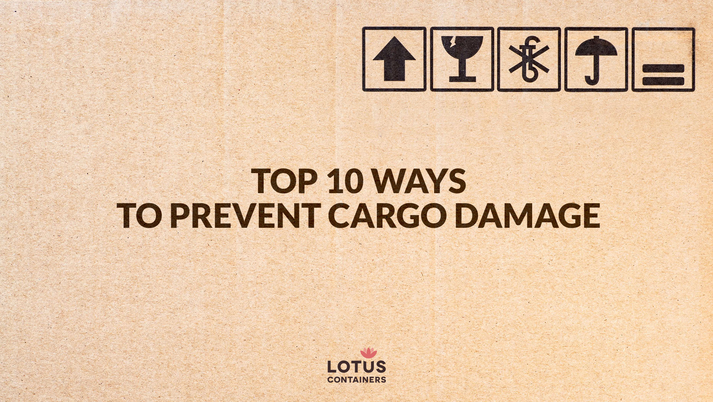Shipping containers and cargo shipping are the cornerstones of global commerce. Every year, billions of cargo containers travel worldwide carrying all essential and non-essential goods. But this most durable, reliant, and heavy-duty invention of Malcolm Mclean doesn’t always prevent cargo damage. The harm may occur due to one or other reasons. And this damage burns a hole in the pocket of the businesspeople by costing them billions of dollars every year.
Every shipper has one aim while cargo transportation; the items must reach the consumers safely. But sometimes, due to insufficient packing, not enough lashing, cargo handling by several parties, or other such issues lead to cargo destruction.
What are the common causes behind cargo damage?
- Cargo mishandling while loading and unloading – When loaders stuff and de-stuff the cargo in the shipping unit, the merchandise passes many hands, which leads to damage of goods.
- Container transportation – During container transportation, the merchandise is shipped via different transportation methods as the goods may move by sea, train, air, or road. And in the way it gets jerks, the cargo can collide, which leads to damage.
- The shipping container is not locked correctly, etc. – When the maritime shipping container doesn’t have the right container lock, the cargo slips away due to the lock opening during the journey.
- Due to leakage, condensation, etc. – The shipping container condensation and container rain damage the antique stuff, paper, documents, and perishables.
- Not enough packing – Improper packing leads to damage as the vehicle moves and goes through sudden movement during cargo transportation. This sudden movement during the container movement damage the products in the cargo box.
- No lashing rings – No lashing rings and ropes will make the goods drift away from one side to another. This collision damages the products.
- Over-stuffing – Overstuffing the goods in the freight container will lead to the suppressing of goods that leads the goods to break or go to waste.
- Slippage – During freight transportation, the goods slip from one side to the other due to movement, thus leading to collision and damage.
How to prevent cargo damage?
Adequate packing
Using the right and adequate packaging can save all the items inside the shipping container. The packaging depends upon the delicacy of the goods inside the box. Other than packing the goods, adequately fill the space with proper padding, bubble wrap, etc. The packing material must be high quality, provide resistance against water, and protect against condensation.
Using right pallets
Use the right and good-quality pallets, or you can buy pallet wide containers from a shipping container supplier. The pallets stop the freight from falling as they avoid friction. The pallets make them stationary and bear all storms and weather. It would help if you secured heavier loads with more durable strapping.
Lessen over-handling by using the correct labels
With the correct labels, you can avoid mishandling of the goods. The labels point to the handler how much weight a body can handle or not. They also show if the cargo is fragile or dangerous. The label that one puts must be clear, visible, identifiable, and without any damage.
Right loading practice
You must keep the heavy load at the bottom for the appropriate weight distribution. Keep all the documents intact, avoid double stacking, use proper cushion and dunnage to fill up the spaces and give the freight the right amount of protection.
Prevent condensation
You must keep checking that the container has proper vents from time to time. Find a reefer container or an insulated container for the perishables. The dedicated containers save the cargo from getting damaged. Usage of proper ventilation and desiccants can prevent cargo damage.
Choosing the correct shipping container
You must not forget to keep an intricate point in mind, i.e., choosing a suitable freight container. If you have bulk goods, you need a 40ft shipping container or a high cube container. And if you have less cargo, you may want 20ft cargo container or smaller ones as well. Also, it would help if you had insulated containers or reefers for fresh or frozen goods. For keeping fluids and gaseous items, you can get tanker containers.
Usage of proper tools
Using the correct tools and machinery helps you put the merchandise in the steel shipping container. If the goods are heavy and you lift them without a forklift, the item may get enormous damage. For putting cargo in the open top container, you will need the help of cranes.
Usage of lashing rings and ropes
Using enough lashing rings and ropes saves the cargo from slipping away as they tighten the stuff and don’t let them slide away. When you don’t use enough lashing rings and strings, you remove the extra protective cover that must be there.
No overstuffing
Never overstuff your cargo container, and always choose the right shipping unit. When you overstuff the goods, they collide with one another or the shipping unit’s insides during the movement and harm the goods. In the case of delicate items, antiques, or perishables, you should never overload the cargo box.
Thus, following the abovementioned top 10 ways, you can save the cargo from damage. And if you need a maritime container, LOTUS Containers is one of the leading shipping container companies. We offer different types of shipping containers in California, Nebraska, Ohio, and other parts of the USA and the world in distinct container dimensions to help your business needs.




